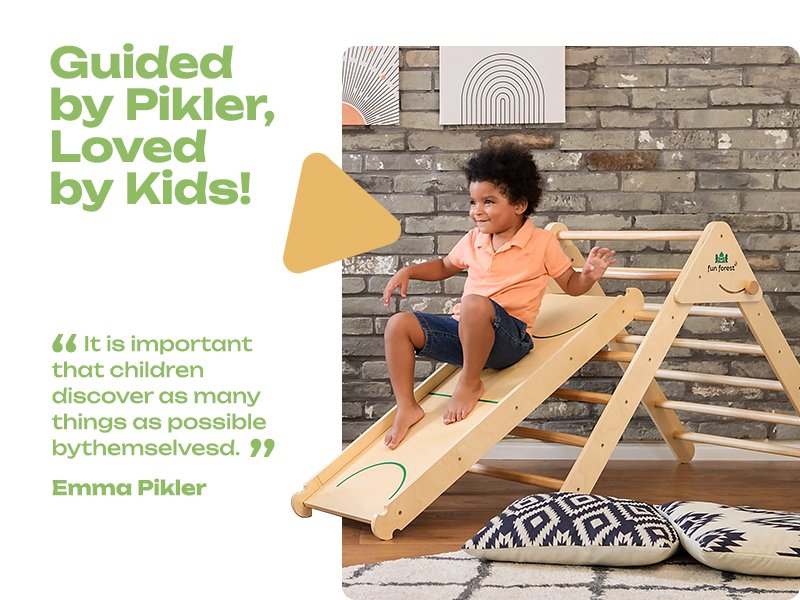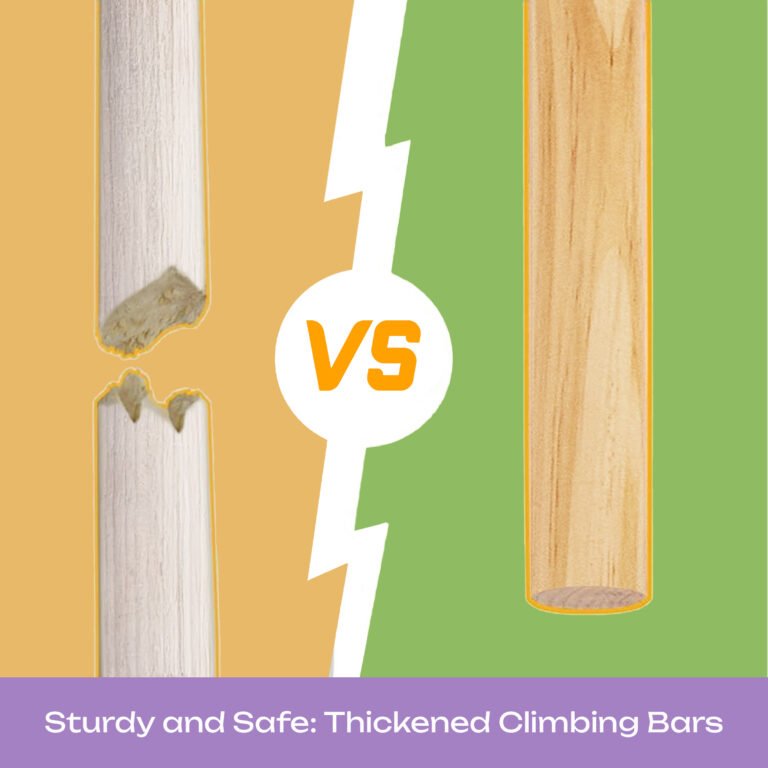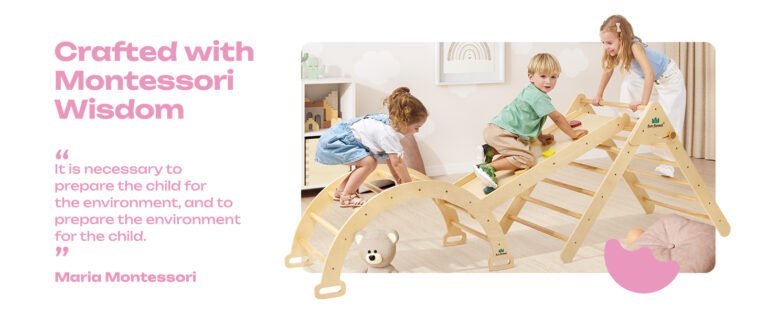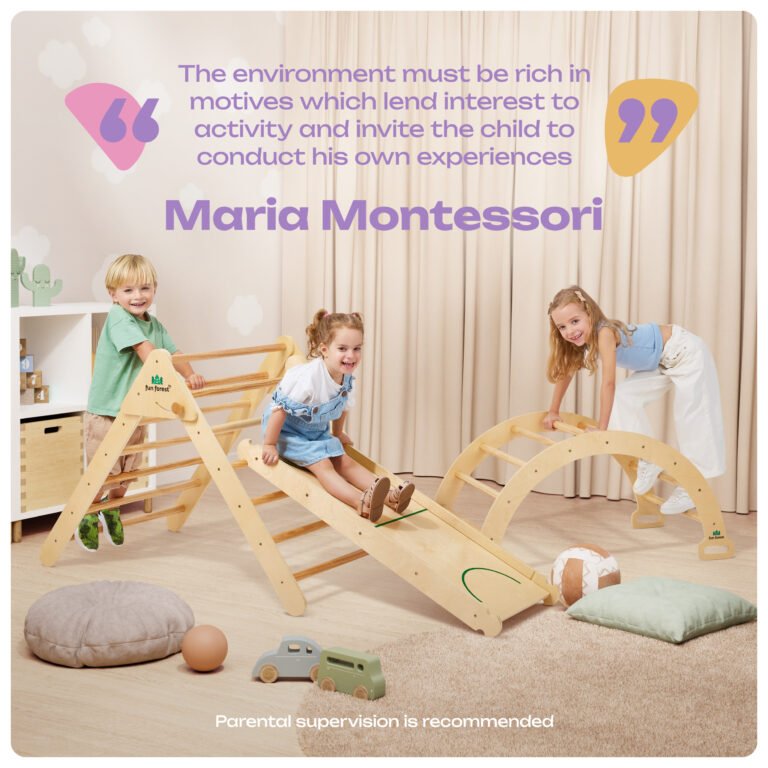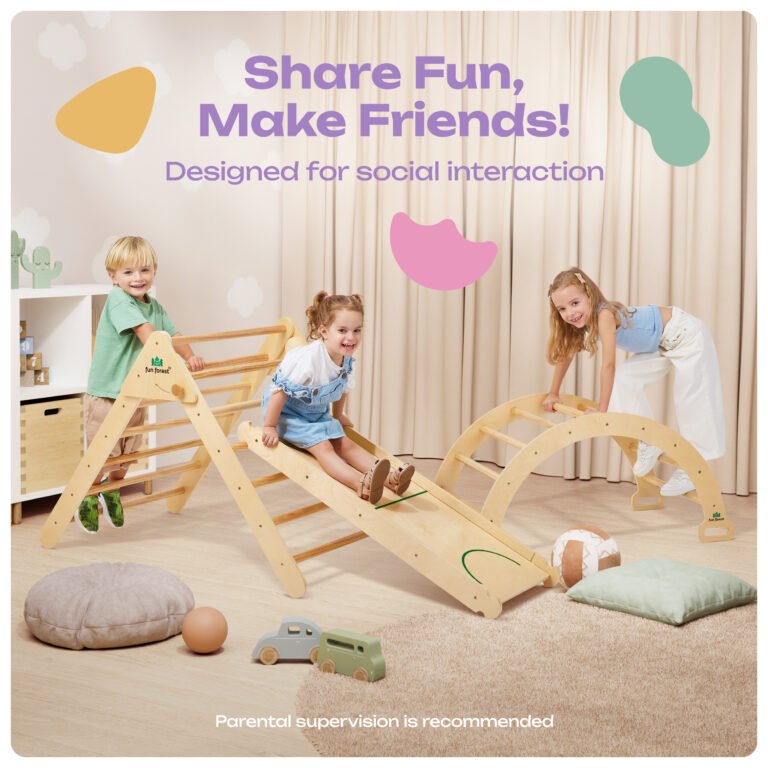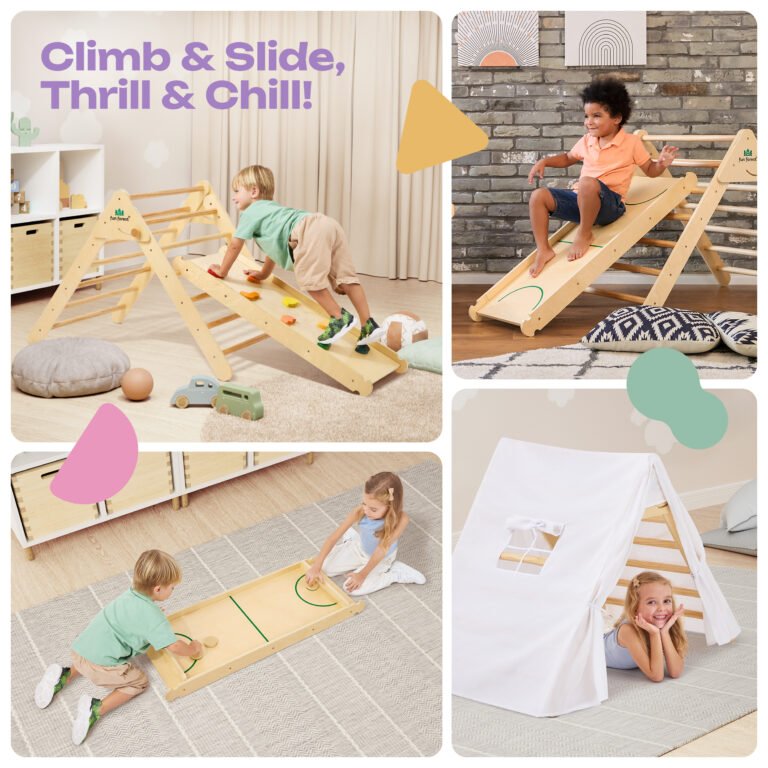How Pikler Triangles Supercharge Your Child’s Motor Skills Development
Every parent dreams of watching their child move with confidence, grace, and natural coordination. From those first wobbly steps to the playground adventures of childhood, motor skills development is one of the most visible and exciting aspects of growing up. But did you know that the foundation for lifelong physical competence can be dramatically enhanced by a simple wooden climbing structure?
The Pikler triangle isn’t just a beautiful piece of play equipment—it’s a motor skills development powerhouse that works with your child’s natural development patterns to build strength, coordination, balance, and confidence in ways that traditional toys simply can’t match.
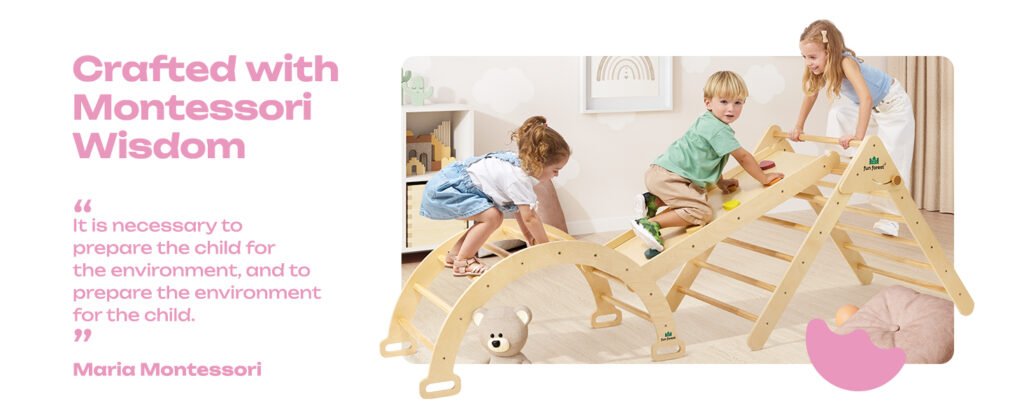
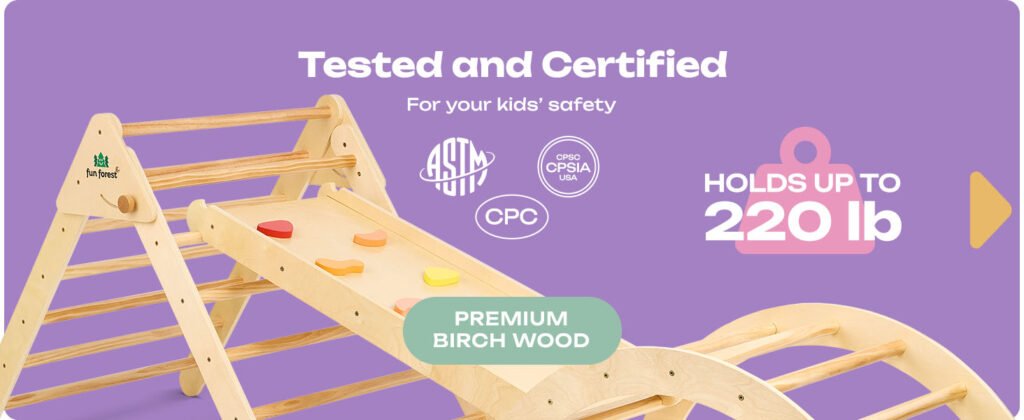
Understanding Motor Skills: The Foundation of Everything
Before diving into how Pikler triangles boost motor development, it’s important to understand what motor skills actually are and why they matter so much for your child’s overall development.
Gross Motor Skills: The Big Movements
Gross motor skills involve the large muscle groups and whole-body movements that form the foundation for all physical activity:
- Balance: Maintaining body position against gravity
- Coordination: Using different body parts together smoothly
- Strength: Developing muscle power for movement and stability
- Spatial Awareness: Understanding body position in space
- Bilateral Integration: Coordinating both sides of the body
Fine Motor Skills: The Precision Movements
Fine motor skills involve smaller muscle groups and precise movements:
- Hand-eye coordination: Visual guidance of hand movements
- Grip strength: Ability to hold and manipulate objects
- Finger dexterity: Individual finger control and precision
- Wrist stability: Foundation for writing and tool use
The Critical Connection
Here’s what many parents don’t realize: gross motor skills provide the foundation for fine motor skills. A child who has strong core muscles, good balance, and confident body awareness will naturally develop better handwriting, drawing skills, and tool use. This is why climbing activities like those provided by Pikler triangles are so crucial for overall development.
The Pikler Triangle: A Motor Skills Gymnasium
The genius of the Pikler triangle lies in how it naturally encourages the exact movements children need for optimal motor development. Every climb, every careful step, every thoughtful reach builds multiple motor skills simultaneously.
Strength Building Through Natural Movement
Unlike artificial exercises or structured fitness programs, the Pikler triangle builds strength through joyful, self-directed play:
Core Strength Development
- Climbing up: Engages abdominal muscles and back extensors
- Maintaining position: Requires constant core stabilization
- Reaching across: Challenges rotational core strength
- Dismounting: Develops controlled eccentric muscle contractions
Upper Body Power
- Pulling up: Builds arm, shoulder, and back strength
- Supporting body weight: Develops grip strength and forearm endurance
- Reaching for higher rungs: Stretches and strengthens shoulder girdle
- Hanging briefly: Builds functional upper body strength
Lower Body Foundation
- Stepping up: Develops leg muscle power and control
- Balance on rungs: Strengthens small stabilizing muscles
- Pushing off: Builds explosive power in legs
- Landing safely: Develops shock absorption and muscle control
Coordination: Where Magic Happens
The Pikler triangle is essentially a three-dimensional coordination puzzle that children solve with their bodies:
Hand-Foot Coordination
Children must coordinate their hands and feet to climb successfully, developing the cross-lateral movement patterns essential for walking, running, and sports.
Bilateral Coordination
Using both sides of the body together while maintaining different functions (one hand holds while the other reaches) builds crucial bilateral integration skills.
Sequential Movement
Planning and executing climbing sequences develops motor planning abilities that transfer to complex activities like dancing, sports, and even academic tasks.
Balance: The Ultimate Integration
Balance isn’t just about not falling—it’s about the sophisticated integration of multiple body systems:
Static Balance
- Holding positions: Pausing mid-climb to assess next move
- Standing on rungs: Maintaining upright position on narrow surfaces
- Reaching while stable: Extending limbs while maintaining center of gravity
Dynamic Balance
- Moving while climbing: Maintaining stability during position changes
- Weight shifting: Transferring weight from limb to limb smoothly
- Directional changes: Turning around or changing climbing direction
Reactive Balance
- Catching themselves: Automatic responses to unexpected shifts
- Adjusting quickly: Responding to environmental changes
- Recovery skills: Regaining balance after near-slips
Age-Specific Motor Skills Development
The beauty of the Pikler triangle lies in how it supports motor development across multiple years, with each age group gaining different but equally important benefits.
Infants (6-12 months): Foundation Building
At this crucial stage, babies are developing the fundamental movement patterns that will support all future motor skills:
Skills Developed:
- Pulling to stand: Crucial prerequisite for walking
- Weight bearing: Strengthening legs for future locomotion
- Grip development: Building hand strength for future climbing
- Visual-motor integration: Learning to coordinate eyes and hands
How the Triangle Helps:
The lowest rungs provide perfect supports for babies learning to pull themselves upright. The stable structure gives them confidence to practice standing and bouncing, building leg strength and balance reactions.
Young Toddlers (12-24 months): Exploration Phase
This is when children typically take their first steps and begin exploring vertical movement:
Skills Developed:
- Cruising: Moving while holding support
- Climbing: First attempts at ascending
- Spatial planning: Understanding how to navigate obstacles
- Risk assessment: Learning physical limitations safely
How the Triangle Helps:
Toddlers can cruise along the base, attempt first climbing moves, and explore the structure safely. The triangle provides graduated challenges that match their developing abilities.
Active Toddlers (2-3 years): Confidence Building
Peak motor learning years when children are fearless and eager to master new skills:
Skills Developed:
- Confident climbing: Reaching the top consistently
- Descending skills: Learning to come down safely
- Complex movements: Combining climbing with reaching and stretching
- Speed control: Learning to move at appropriate pace
How the Triangle Helps:
Children can climb confidently to the top, experiment with different routes, and begin incorporating imaginative play that adds complexity to their movements.
Preschoolers (3-6 years): Mastery and Creativity
Advanced motor skills and creative movement combinations:
Skills Developed:
- Advanced coordination: Complex movement sequences
- Teaching others: Demonstrating and explaining techniques
- Creative movement: Inventing new ways to use the structure
- Speed and agility: Quick, confident navigation
How the Triangle Helps:
The triangle becomes a platform for creative movement, teaching opportunities, and increasingly sophisticated physical challenges that prepare children for sports and complex physical activities.
The Science Behind the Benefits
Modern research consistently validates what Dr. Pikler observed decades ago: free movement and climbing activities provide profound developmental benefits.
Neurological Development
Climbing activities stimulate multiple brain regions simultaneously:
Vestibular System
- Balance processing: Inner ear sensors activated by position changes
- Spatial orientation: Understanding body position relative to gravity
- Movement integration: Coordinating balance with visual input
Proprioceptive System
- Body awareness: Sensors in muscles and joints providing position feedback
- Force regulation: Understanding how much pressure to apply
- Movement precision: Fine-tuning motor control
Cross-Lateral Brain Activation
- Corpus callosum development: Strengthening connections between brain hemispheres
- Integrated processing: Both sides of brain working together
- Academic preparation: Building neural foundations for reading and math
Physical Benefits Backed by Research
Bone Density
Weight-bearing climbing activities increase bone density, providing lifelong skeletal health benefits.
Muscle Development
Functional movement patterns build muscles in ways that support natural movement and prevent injury.
Cardiovascular Health
Active climbing provides excellent cardiovascular exercise in a fun, sustainable format.
Real-World Transfer: How Triangle Skills Become Life Skills
The motor skills developed on a Pikler triangle don’t stay on the triangle—they transfer to countless real-world activities:
Academic Success
- Improved handwriting: Core strength and bilateral coordination translate to better pencil control
- Better attention: Physical competence supports longer focus periods
- Enhanced learning: Movement activities boost cognitive function
Sports and Recreation
- Natural athletes: Children with strong fundamental movement skills excel in sports
- Injury prevention: Good body awareness and balance reduce injury risk
- Lifelong activity: Physical confidence encourages continued activity participation
Daily Life Skills
- Playground confidence: Comfortable with climbing structures and physical challenges
- Safety awareness: Better risk assessment and body control
- Independence: Physical competence supports general independence
Maximizing Motor Skills Development
To get the most motor development benefits from your Pikler triangle:
Environment Setup
- Safe landing surface: Foam mats or thick rugs for confidence
- Adequate space: Room to move around all sides safely
- Good lighting: Clear visibility for safe navigation
- Minimal distractions: Focus on physical challenge and body awareness
Parental Support
- Hands-off approach: Allow child-led exploration and problem-solving
- Emotional encouragement: Support confidence without directing movement
- Safety supervision: Watch for genuine safety issues while allowing appropriate risk
- Celebrate effort: Focus on attempt and improvement rather than achievement
Progressive Challenge
- Start simple: Begin with basic pulling up and stepping
- Follow the child: Let them set the pace for advancement
- Add complexity gradually: Introduce new challenges as skills develop
- Maintain interest: Rotate accessories or change setup occasionally
Fun Forest: Motor Skills Development Designed Right
When choosing a Pikler triangle for motor skills development, the Fun Forest collection offers the perfect combination of safety, functionality, and developmental appropriateness:
🌲 Fun Forest Pikler Triangle
Perfect for focused motor skills development:
✅ Optimal rung spacing for developing grip strength and coordination
✅ Stable triangular design that builds confidence for risk-taking
✅ Premium construction that supports vigorous climbing safely
✅ Appropriate height that challenges without overwhelming
✅ Smooth finish that protects hands while allowing secure grip
✅ Foldable design for safe storage when not in use
🎯 Complete Fun Forest Pikler Set
Maximum motor skills development opportunities:
🏃 Multiple movement challenges that prevent skill plateaus
🧗 Progressive difficulty levels that grow with your child
🤸 Varied motor patterns that develop well-rounded physical abilities
🎪 Creative configurations that maintain long-term engagement
🏆 Comprehensive development across all motor skill domains
The Long-Term Investment in Physical Competence
Investing in your child’s motor skills development through a Pikler triangle is an investment in their lifelong physical competence and confidence. The strength, coordination, balance, and body awareness they develop will serve them in countless ways:
- Academic performance: Strong motor skills support learning
- Social confidence: Physical competence builds overall self-esteem
- Injury prevention: Good body awareness and strength prevent accidents
- Lifelong health: Early movement experiences shape activity preferences
- Independence: Physical confidence supports general independence
Start Building Motor Skills Today
Your child’s motor skills development doesn’t wait for the perfect moment—it’s happening right now, with or without optimal support. The question isn’t whether your child will develop motor skills, but whether they’ll have the best possible foundation for physical competence and confidence.
A Pikler triangle provides that foundation in the most natural, joyful way possible. Every climb builds strength. Every careful step develops coordination. Every successful navigation to the top builds confidence that will serve your child for life.
Ready to supercharge your child’s motor skills development?
🌟 Start with the Fun Forest Pikler Triangle for focused, foundational motor skills building
🎯 Or choose the Complete Fun Forest Set for comprehensive motor development across all skill areas
Your child’s journey to physical competence and confidence begins with a single climb. Give them the tools they need to build strength, coordination, and confidence that will last a lifetime.
The foundation for lifelong physical competence starts here. Start building today.

